
Nowadays, businesses are turning to loyalty programs to keep their customers coming back and to improve their shopping experiences. These programs reward repeat customers, fostering loyalty and driving up sales. On an e-commerce platform like Shopify, a well-designed loyalty program can set a brand apart from its competitors.
For most businesses loyalty programs offer more than just repeat customers. These programs provide valuable insights into customer preferences, which help companies create personalized marketing campaigns and promotions. This tailored approach leads to better customer engagement and higher sales in the result.
From the customer's perspective, loyalty programs offer rewards, discounts, and exclusive offers, making shopping not only more enjoyable but also more cost-effective. Integrating loyalty programs into your Shopify store is seamless which enhances the overall shopping experience for your customers.
By creating a sense of belonging, loyalty programs increase customer satisfaction and loyalty.
In this article, we will explore how to create a loyalty program, how they can help your business, and the benefits they offer to customers.
Let's dive in!
What is a Customer Loyalty Program?

A customer loyalty program is a strategy businesses use to reward customers for their continued patronage. These programs offer incentives to encourage repeat purchases and foster customer loyalty.
Rewards in loyalty programs can vary widely. They may include free products, early and exclusive access to new products or events, point systems, awards, or exclusive merchandise. The goal is to show appreciation for customers' business and encourage ongoing engagement with the brand.
Key Benefits of Customer Loyalty Programs
Every business can benefit from establishing a customer loyalty program that offers exclusive perks to its customers. You might already be familiar with similar programs, like frequent flyer miles or referral bonuses.
In a crowded and competitive market, loyalty programs can help set your business apart from competitors and retain your customers. Knowing they can earn rewards or special deals makes customers more likely to return to your store or restaurant.
Loyal customers often make repeat purchases, but that's just one advantage of these programs. Below, we will explore the various benefits that a customer loyalty program can bring to your business and how it can help build customer loyalty.
Increased Customer Retention
In today’s market, customers value shared principles, engagement, and emotional connections with brands. The 2024 Global Customer Loyalty Report found that 81.4% of businesses reported loyalty programs were beneficial during economic downturns, highlighting their importance in customer retention.
Loyalty programs offer personalized rewards and diverse redemption options, enhancing customer satisfaction and retention. This encourages repeat purchases and ongoing engagement. For instance, home service companies can use regular maintenance plans to keep customers engaged and reduce churn.
By consistently providing value and personalized experiences, loyalty programs significantly extend the duration customers stay with a brand, making them essential for business success.
Higher Customer Lifetime Value (CLV)
Loyalty programs significantly enhance customer lifetime value (CLV) by increasing purchase frequency and average spend. Customers in loyalty programs are more likely to shop frequently to earn rewards, leading to more transactions over time.
According to a Bond Brand Loyalty report, 77% of consumers say loyalty programs make them more likely to continue doing business with brands.
Additionally, loyalty programs encourage higher spending per visit. Customers aiming to reach reward milestones tend to add more items to their cart or choose higher-priced products. This behavior boosts immediate transaction value and fosters long-term loyalty.
A study by Capgemini found that customers in loyalty programs spend up to 18% more than those who do not.
Enhanced Customer Engagement
Loyalty programs actively encourage customers to interact with brands through various channels, deepening engagement and connection. By offering rewards, exclusive offers, and personalized experiences, these programs incentivize customers to participate in activities beyond purchases, such as surveys, social media interactions, and refer-a-friend campaigns. According to Accenture, 57% of consumers spend more on brands to which they are loyal.
Digital platforms play a crucial role in enhancing customer interaction in loyalty programs. Mobile apps, email marketing, and social media provide seamless ways for customers to stay connected with the brand.
A study by Bond Brand Loyalty found that 95% of loyalty program members want to engage with their brand’s program through new and emerging technologies like apps.
This multi-channel approach not only keeps customers engaged but also strengthens their emotional connection with the brand.
Improved Customer Experience
Loyalty programs significantly enhance the customer experience by offering personalized offers and exclusive benefits. By leveraging customer data, brands can tailor promotions to individual preferences, making customers feel valued and understood.
For example, personalized discounts on frequently purchased items or product recommendations based on past behavior create a more engaging shopping experience.
According to McKinsey, integrating personalized offers can improve customer satisfaction and drive long-term engagement.
Exclusive benefits such as early access to sales, VIP events, or member-only services add a sense of privilege and uniqueness. These perks foster a deeper emotional connection with the brand.
Loyalty360 highlights that customers who feel special and valued by these exclusive perks are more likely to remain loyal, enhancing their overall shopping experience. This personalized and exclusive approach ensures customers have a more enjoyable interaction with the brand, boosting loyalty and retention.
Positive Word-of-Mouth and Referrals
Satisfied loyalty program members often become brand ambassadors, spreading positive word-of-mouth and recommending the brand to their friends and acquaintances. This natural form of promotion is highly effective, as people trust recommendations from those they know.
Loyalty programs that offer referral bonuses can amplify this effect by incentivizing members to refer others, which not only brings in new customers but also strengthens the bond between existing customers and the brand.
According to Deloitte, referred customers have a higher retention rate and are more likely to refer others.
Moreover, satisfied members are likely to share their experiences on social media, further extending the reach of their recommendations. This cycle of referrals and positive word-of-mouth significantly boosts customer acquisition and loyalty.
Increased Sales and Revenue
Loyalty programs boost sales and revenue by encouraging frequent purchases. Members shop more often to earn rewards, increasing transaction volume. A study by Accenture found that members of loyalty programs generate 12-18% more revenue growth per year than non-members.
Additionally, these programs facilitate cross-selling by offering personalized product recommendations, which increases average order value. Personalized offers lead to higher spending as customers add recommended items to their cart.
Higher average order values are also achieved through tiered loyalty programs that incentivize spending more to unlock additional benefits. This strategy boosts revenue by encouraging customers to increase their purchase amounts, enhancing overall spending and driving sustained revenue growth.
Data Collection and Insights
Loyalty programs help businesses gather valuable customer data, offering insights into purchase history, preferences, and behaviors. This information allows companies to understand which products and services resonate most with their customers, enabling more effective marketing strategies.
Using this data, businesses can create personalized marketing campaigns, tailored promotions, and targeted offers. This enhances customer satisfaction and increases marketing effectiveness, leading to better engagement and loyalty.
Additionally, businesses can identify trends and make informed decisions about product development and inventory management. This ensures that marketing strategies are data-driven and customer-centric, improving overall business performance.
Types of loyalty programs
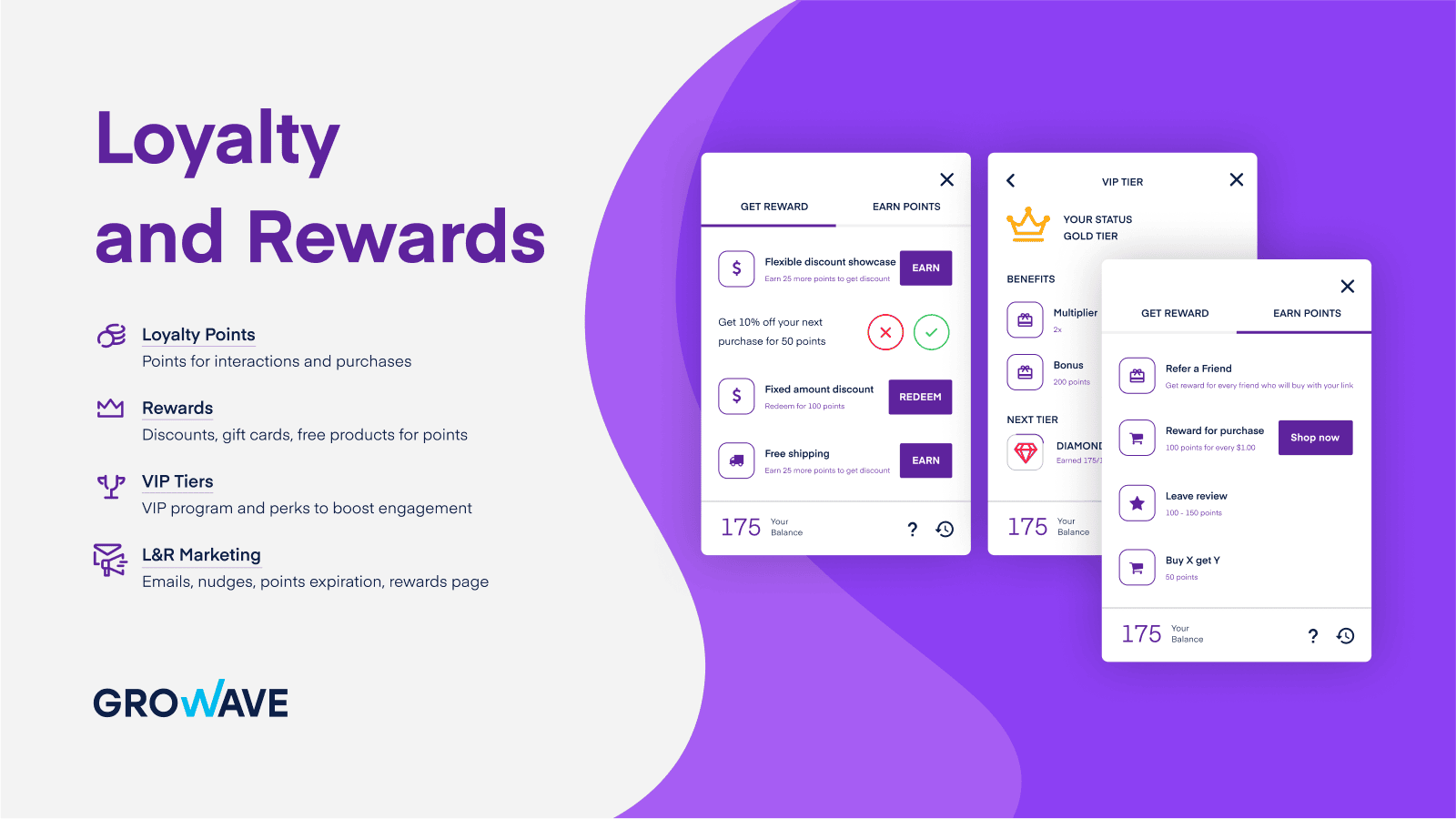
Now that you understand the benefits of loyalty programs, let's explore different types to determine which format suits your business best. Consider your business’s average transaction size, customer return frequency, and the time between visits when choosing a loyalty program.
Points-Based Loyalty
Points-based loyalty programs are the most common. Customers earn points for activities like purchases, social media engagement, reviews, and celebrating milestones. These points can be redeemed for rewards such as cashback, discounts, or free items, encouraging frequent interaction and purchases.
Tiered Loyalty
Tiered programs reward customers based on their spending or engagement levels. Higher tiers offer more valuable rewards, motivating customers to increase their spending to reach the next level. This structure creates a sense of achievement and loyalty as customers strive for better benefits.
For more information on how to implement these loyalty programs and choose the best format for your business, read the full article here.
Strategies for Creating a Successful Customer Loyalty Program
Before you create a customer loyalty program, it's crucial to have a clear strategy in place to ensure its success. Here are some strategies to help you build a successful loyalty program for your brand:
Understanding Your Customer Base
Understanding your customer base is crucial when creating a loyalty program that truly resonates with your audience and meets their needs. This leads to higher engagement and satisfaction.
To gather this understanding, collect customer data through various methods such as surveys, purchase history analysis, and social media interactions. Analyzing this data helps you identify customer preferences, behaviors, and trends.
Tools like CRM systems and analytics platforms can assist in processing this data to create detailed customer profiles. With this comprehensive understanding, you can create personalized and relevant loyalty programs that drive customer loyalty and business growth.
Defining Program Objectives and Goals
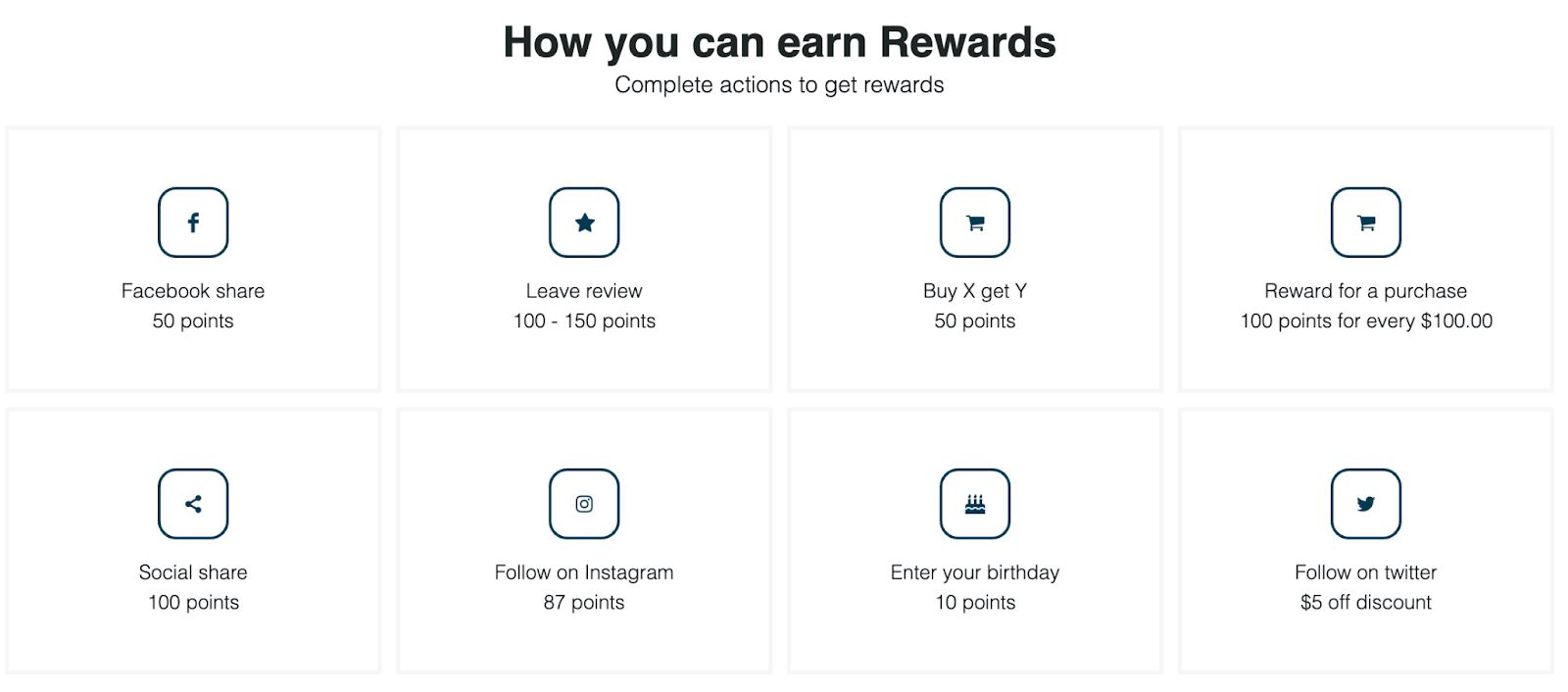
When you create a loyalty program, it's important to align its goals and objectives with your overall business strategy. Start by identifying your key business priorities, such as increasing customer retention, boosting average order value, or expanding market share.
Consider how a loyalty program can support these priorities. For instance, if your goal is to increase customer retention, focus on rewarding repeat purchases. Make sure the program's objectives are measurable and achievable by setting clear KPIs, such as target retention rates or revenue growth from loyalty members.
By aligning your loyalty program with your strategic goals, you ensure that it not only engages customers but also drives business growth.
Choosing the Right Type of Loyalty Program
Different types of loyalty programs suit various business models and customer behaviors.
Points-based programs reward purchases with points redeemable for discounts, ideal for frequent transactions like retail.
Tiered programs offer escalating rewards based on spending, suitable for businesses with a wide product range.
Cumulative programs reward total spending over time, encouraging long-term loyalty, perfect for subscription services.
Multi-level programs combine points and tiers, offering flexibility across customer segments, while bonus programs give immediate rewards for actions like sign-ups or referrals, effective for new businesses. Each type serves different business needs and customer behaviors.
To choose the right program, consider your business model, customer purchasing patterns, and strategic goals. Analyze customer data to align the program with your objectives, ensuring it meets both business needs and customer expectations for success.
Designing Reward Tiers and Benefits
When designing reward tiers, analyze customer data to define spending and engagement patterns. Set clear criteria for tier progression, ensuring the entry-level tier is easily reachable to encourage participation. Higher tiers should require more engagement, offering significant rewards that justify the effort.
Align rewards with customer preferences by using feedback and data analysis. Offer a variety of rewards, including monetary benefits like discounts and experiential rewards like exclusive events. Ensure the value and exclusivity of rewards increase with each tier to motivate customers to climb the loyalty ladder.
Personalize rewards based on individual preferences to enhance appeal. Regularly communicate tier status and available rewards to maintain customer excitement and motivation, ensuring the program's success.
Effective Communication and Marketing
Effective communication and marketing are key to successfully implementing and promoting a loyalty program. Clear and consistent messaging helps customers understand the benefits and how to participate. Utilizing multiple channels like email, social media, and in-store promotions ensures you reach a wider audience and reinforce the program's presence.
Marketing should emphasize the value of the loyalty program, making it appealing to potential members. Personalized messages tailored to customer preferences boost engagement and satisfaction. Regular updates about rewards, exclusive offers, and tier status keep the program top-of-mind and encourage ongoing participation.
By integrating communication and marketing strategies, businesses can attract new members, retain existing ones, and ensure sustained customer loyalty and increased revenue.
Monitoring and Optimization
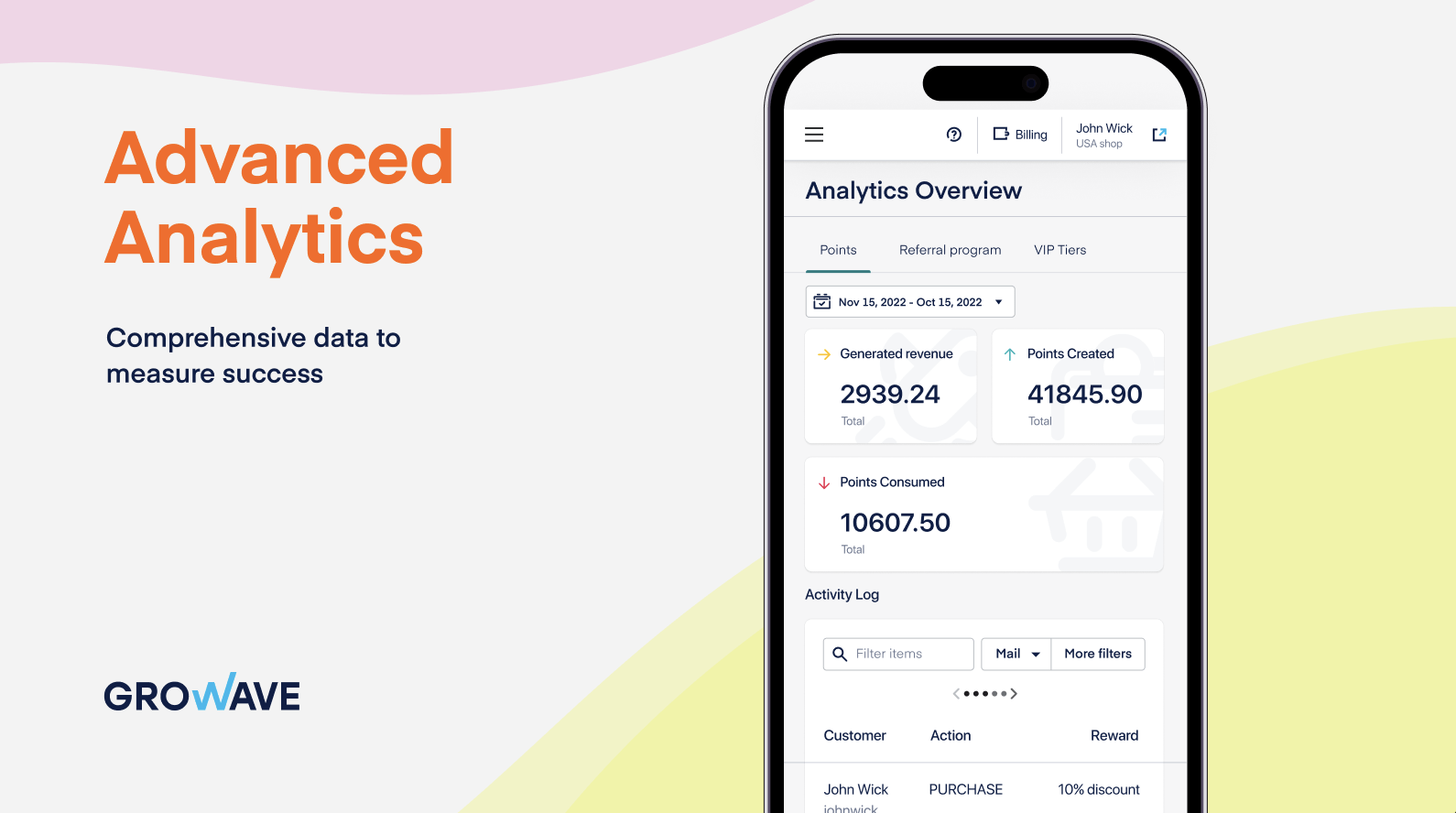
Continually monitoring and optimizing a loyalty program is essential for sustained success. Set key performance indicators (KPIs) like enrollment rates, participation, repeat purchases, and average order value. Use analytics tools to track these metrics regularly.
Gather customer feedback through surveys and reviews to understand their experiences and identify improvement areas. Analyze this data to make data-driven adjustments, such as modifying rewards or enhancing communication strategies.
Use A/B testing to experiment with different program elements and stay informed on industry trends and competitor strategies. Regularly reviewing performance data and making necessary changes ensures the program remains effective, enhancing customer engagement and driving business growth.
Examples of Successful Customer Loyalty Programs
Let's take a look at successful loyalty programs from well-known brands like Sephora, Starbucks, Amazon Prime, and Nike. These examples can serve as inspiration for creating your own program, showcasing effective strategies to engage and retain customers.
Example 1: Sephora Beauty Insider
A great example of a successful loyalty program is Sephora's Beauty Insider. Its success lies in its tiered structure, personalized rewards, and engaging customer experience, which drive customer loyalty and repeat business.

The program has three levels: Beauty Insider, VIB (Very Important Beauty Insider), and Rouge, each offering increasing benefits based on annual spending:
- Beauty Insider: Free to join, earning 1 point per dollar spent. Benefits include birthday gifts, free beauty classes, and access to promotions.
- VIB: For customers spending $350 annually, earning 1.25 points per dollar. Additional perks include extra discounts during seasonal events, free beauty services, and exclusive products.
- Rouge: For customers spending $1,000 annually, earning 1.5 points per dollar. Benefits include free standard shipping, early access to sales, exclusive events, and free custom makeovers.
Points can be redeemed for deluxe samples, full-sized products, and exclusive experiences. Members enjoy personalized recommendations and early access to new products and sales, enhancing their overall shopping experience. The program's mix of valuable rewards and exclusive perks makes it highly appealing and effective in fostering customer loyalty.
Example 2: Starbucks Rewards
The Starbucks Rewards program is a highly successful and popular loyalty initiative, boasting over 16 million active members in the U.S. as of 2021. Its success is attributed to seamless app integration, personalized offers, and frequent promotions that keep customers engaged and returning.
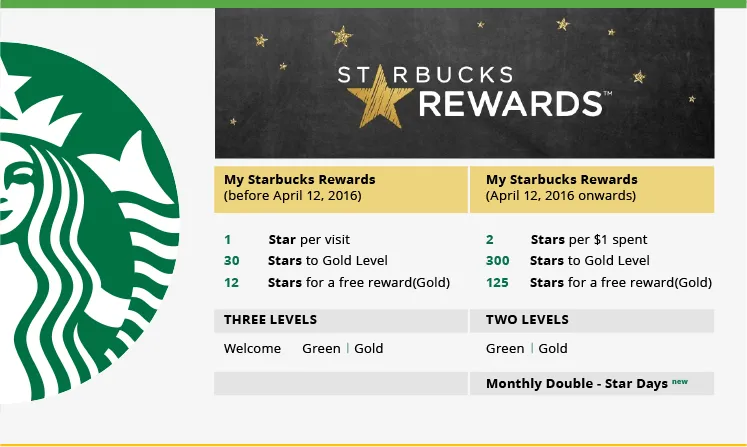
Customers sign up for free, earn 2 stars per dollar spent, and redeem stars for rewards. Special benefits like free birthday drinks and exclusive offers enhance the experience, while accumulating stars allows customers to advance to higher tiers with more perks.
The program features two primary levels: Green and Gold.
Green Level members earn 2 stars per dollar spent and enjoy benefits such as a free birthday drink, free in-store refills on brewed coffee and tea, and access to exclusive offers.
Gold Level is achieved after earning 300 stars in 12 months, offering all Green Level benefits plus a free item for every 125 stars, a personalized Gold Card, and additional exclusive offers.
Members can redeem stars for rewards ranging from customizations and free brewed coffee to handcrafted drinks, lunch items, and select merchandise.
The program’s popularity is driven by its convenience, personalization, and consistent engagement through the Starbucks app, which makes it easy for customers to earn and redeem stars, place orders, and access personalized offers. Frequent promotions and special events keep the program exciting and engaging for members.
Example 3: Amazon Prime
The Amazon Prime loyalty program is renowned for its extensive benefits and unique features that cater to a wide range of customer needs, making it one of the most popular subscription services globally.
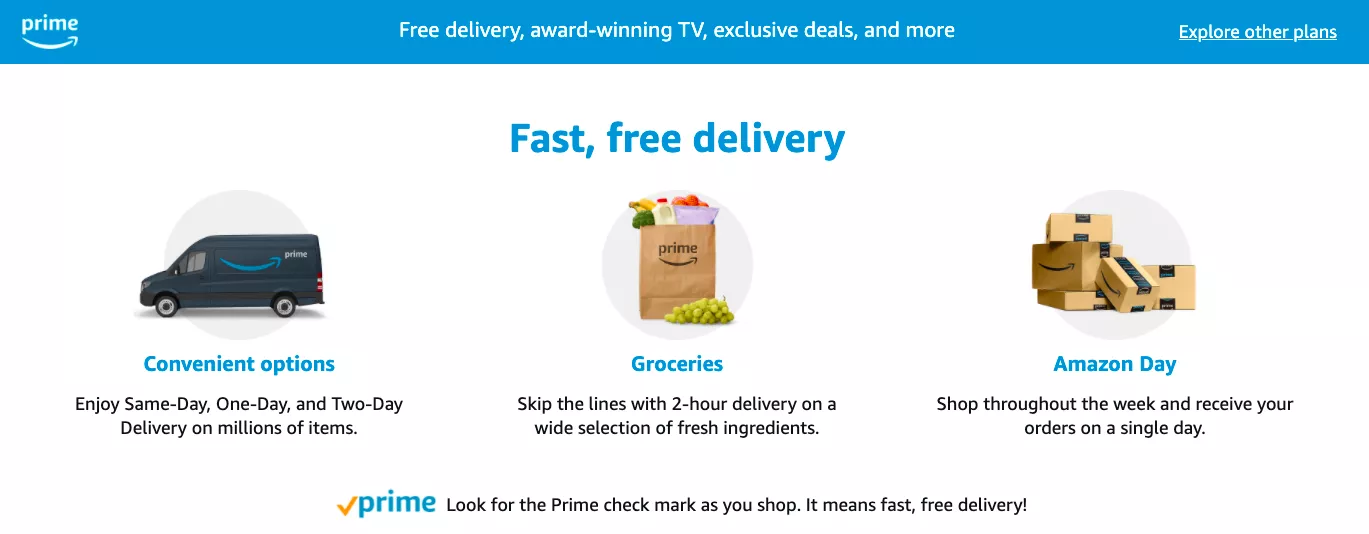
Unique Features of Amazon Prime
- Fast and Free Shipping: One of the primary attractions of Amazon Prime is the fast and free shipping options. Members enjoy free two-day shipping on millions of items, with some areas offering same-day or even two-hour delivery through Prime Now.
- Streaming Services: Amazon Prime includes access to Prime Video, a streaming service with a vast library of movies, TV shows, and original content. Additionally, Prime members have access to Prime Music, which offers a catalog of over two million songs and playlists without ads.
- Exclusive Deals and Early Access: Members receive exclusive access to special shopping deals, including lightning deals and Prime Day discounts. This early access can be a significant draw for frequent shoppers looking for the best prices.
- Prime Reading and Kindle Benefits: Prime members have access to Prime Reading, which includes a rotating selection of books, magazines, and more. Additionally, members can borrow books from the Kindle Owners' Lending Library and enjoy discounts on Kindle eBooks.
- Amazon Fresh and Whole Foods Market Discounts: In select areas, Prime members can use Amazon Fresh for grocery deliveries. Additionally, they enjoy exclusive discounts at Whole Foods Market.
Benefits for Customers
- Convenience: The fast and free shipping options greatly enhance shopping convenience, allowing members to receive their purchases quickly without additional shipping costs.
- Entertainment: Access to Prime Video and Prime Music provides a significant value-add, offering a wide range of entertainment options without the need for additional subscriptions.
- Savings: Exclusive deals, early access to sales, and discounts at Whole Foods Market help members save money, making the membership fee more than worthwhile for frequent shoppers.
- Reading and Grocery Benefits: Access to a rotating selection of reading materials and grocery delivery services further extends the program's value into everyday needs.
The Amazon Prime program's comprehensive benefits and unique features create a compelling value proposition for customers, contributing to its widespread popularity and success.
Example 4: Nike Membership
Another great example of a successful loyalty program is the Nike Membership program. Designed to reward loyal customers with exclusive benefits, personalized services, and unique experiences, Nike's program enhances customer engagement and fosters a strong community around the brand.
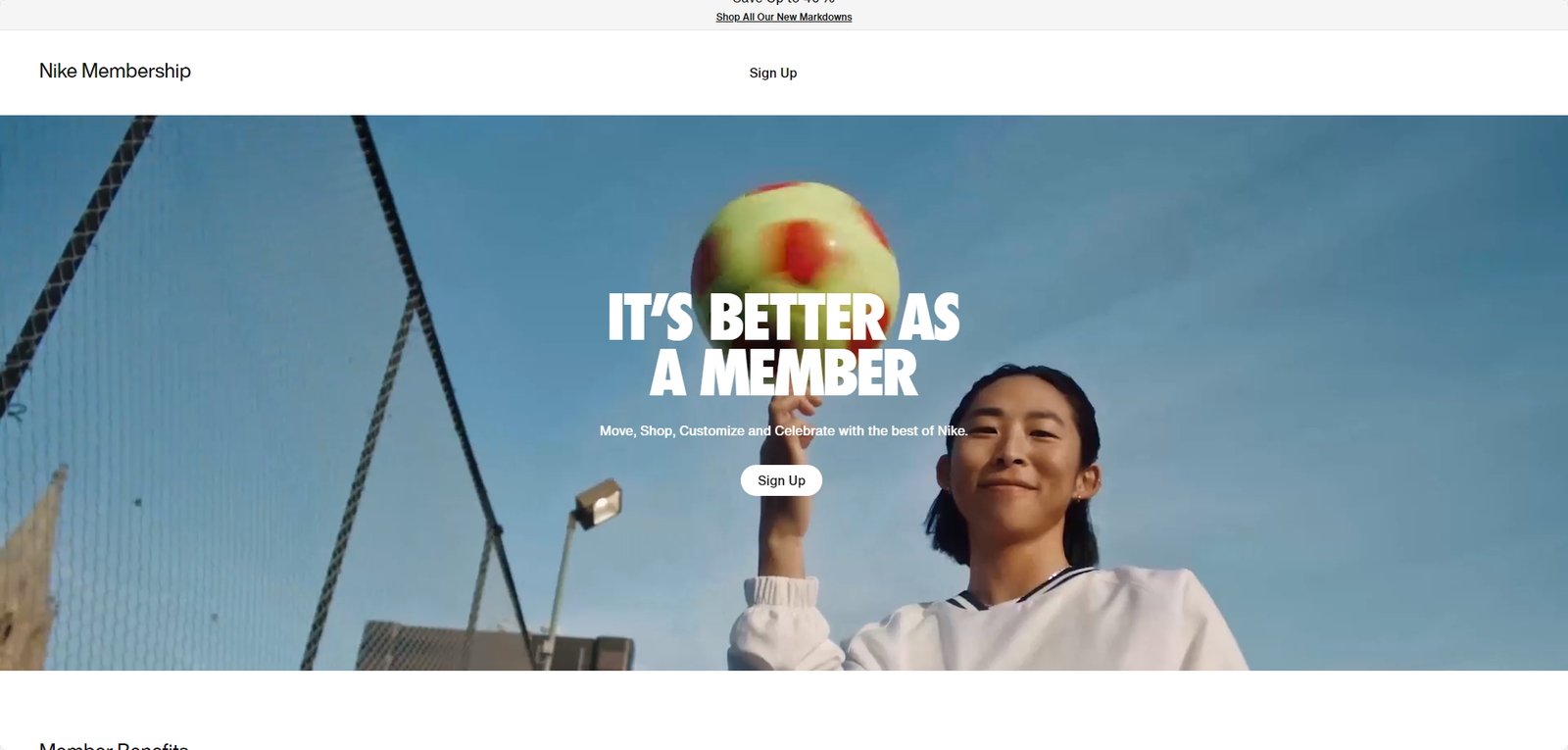
Unique Features and Rewards
- Exclusive Products and Early Access: Members gain early access to new releases and exclusive products, which is particularly appealing to sneaker enthusiasts and collectors.
- Personalized Services: Through the Nike Training Club and Nike Run Club apps, members receive personalized workout recommendations, training programs, and expert advice, helping them achieve their fitness goals.
- Member-Only Events: Nike organizes exclusive events for members, such as fitness classes, sports clinics, and special shopping events, which build a sense of community and offer unique experiences.
- Special Discounts and Offers: Members benefit from special discounts and promotions throughout the year, including birthday discounts and member-only sales.
- Free Shipping and Returns: Membership includes free standard shipping on all orders and free returns, making online shopping more convenient.
- Personalized Shopping Experience: Members receive personalized product recommendations based on their purchase history and preferences, enhancing their shopping experience.
The Nike Membership program has achieved significant success, boasting a large and active member base. Its focus on personalization and exclusive access appeals strongly to Nike's customers, encouraging frequent engagement and loyalty. By integrating fitness and training resources with shopping benefits, Nike creates a comprehensive and engaging customer experience.
Nike’s strategy of providing personalized experiences, exclusive access, and community-building events has helped maintain a strong connection with its customers, driving repeat business and brand advocacy. This has positioned Nike as a leader in customer loyalty and engagement within the athletic and lifestyle segments.
Challenges and Solutions in Implementing Customer Loyalty Programs
Now that you’ve learned about some successful loyalty programs from well-known brands, let’s explore the challenges you might face when setting up a loyalty program and discuss strategies to overcome them.
Ensuring Fairness and Accessibility
To make sure your loyalty program is fair and accessible to everyone, offer various ways to earn points besides just making purchases. Activities like writing reviews, sharing on social media, and participating in surveys allow customers with different spending abilities to accumulate points and feel valued.
Create a tiered rewards system with benefits at different levels of engagement. Make sure the entry-level tier is easy to reach, providing immediate rewards to new members and encouraging participation from all customers, regardless of their spending habits.
Offer a variety of rewards that appeal to different preferences and budgets, from small, easily attainable rewards to larger, exclusive ones. This ensures all customers, whether they shop occasionally or frequently, find value in the program.
Be transparent about how points are earned and redeemed, and keep the process simple. Regularly update members on their progress and available benefits to encourage ongoing participation. Use feedback to adjust the program based on customer needs, ensuring it remains fair and relevant.
Balancing Cost and Benefits
To balance the costs and benefits of a loyalty program, start by defining your budget and objectives. Determine key metrics like customer retention, average order value, and purchase frequency. Align the program’s goals with your business strategy to ensure the benefits justify the investment.
Implement a tiered rewards system that scales with customer engagement. Offer small discounts or exclusive content to new members, reserving higher-value rewards for your most loyal customers. This approach helps manage costs effectively.
Use data analytics to monitor the program's performance. Track metrics like customer participation, redemption rates, and sales lift. This data will help you understand which aspects of the program drive the most value and which need refinement.
Incorporate customer feedback to continuously improve the program. Understanding what rewards and benefits customers value most helps tailor the program to their needs while keeping costs under control. By balancing rewards with expenses, you can create a sustainable loyalty program that drives long-term business growth.
Keeping Customers Engaged
To keep customers interested in your loyalty program, regularly update the rewards catalog with new and exciting options. Use limited-time offers and seasonal promotions to create urgency and encourage frequent engagement.
Personalization is crucial, therefore, use customer data to tailor rewards and communications to individual preferences. You can offer personalized perks like birthday rewards or recommendations based on past purchases to make customers feel valued.
Engage customers across multiple channels, including email, mobile apps, social media, and in-store promotions. Add gamification elements like challenges, leaderboards, and milestones to make the program interactive and fun.
Foster a sense of community among members with exclusive events, online forums, or social media groups. Regularly ask for and act on member feedback to show that their opinions matter, enhancing their commitment to the program.
Conclusion
In conclusion, creating a successful loyalty program involves understanding your customer base, setting clear objectives, choosing the right program type, and designing attractive reward tiers.
Ensuring fairness, balancing costs and benefits, and maintaining engagement through personalized and dynamic rewards are key strategies.
By implementing these steps thoughtfully, you can build a loyalty program that drives customer satisfaction and long-term business growth.
What is your current returning customer rate?
Want to close the gap?
FAQ
What is a customer loyalty program?
A customer loyalty program is a strategy businesses use to reward customers for their continued patronage. These programs offer incentives to encourage repeat purchases and foster customer loyalty. Rewards can vary widely, including free products, early access to new items, point systems, or exclusive merchandise. The goal is to show appreciation for customers' business and encourage ongoing engagement with the brand.
What steps are involved in creating a loyalty program?
Creating a loyalty program involves several key steps:Gather data on customer preferences and behaviors through surveys, purchase history, and social media interactions.Define Program Objectives and align the program's goals with your business strategy, such as increasing retention or boosting average order value.Choose the Right Program Type that suits your business model and customer purchasing patterns.- Design Attractive Rewards and offer incentives that are valuable and relevant to your customers.Implement Effective Communication to promote the program through various channels to ensure customer awareness and participation.Monitor and Adjust the program's performance and make necessary optimizationsFollowing these steps can help establish a successful loyalty program that enhances customer satisfaction and drives business growth.
What are the benefits of implementing a loyalty program?
Implementing a loyalty program offers several advantages:Increased Customer Retention: Loyalty programs encourage repeat purchases by rewarding customers, fostering a sense of belonging and appreciation.Higher Customer Lifetime Value (CLV): By incentivizing continued engagement, customers are likely to spend more over time, increasing their overall value to the business.Enhanced Customer Engagement: Personalized rewards and exclusive offers keep customers engaged and more connected to the brand.Competitive Advantage: In a crowded market, a well-designed loyalty program can differentiate a brand and attract more customers.These benefits collectively contribute to sustained business growth and a stronger customer base.
How do I choose the right type of loyalty program for my business?
Selecting the appropriate loyalty program depends on your business model and customer behavior. Common types include:Points-Based Programs: Customers earn points for purchases, which can be redeemed for rewards. Ideal for frequent transactions.Tiered Programs: Customers achieve different status levels based on their spending, unlocking various benefits. Suitable for businesses aiming to encourage higher spending.Cumulative Programs: Rewards are based on the total amount spent over time, promoting long-term loyalty.Assess your business goals and customer preferences to determine the most effective program structure.
Trusted by over 15000 brands running on Shopify








